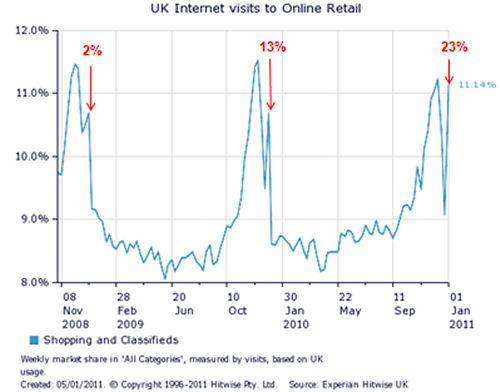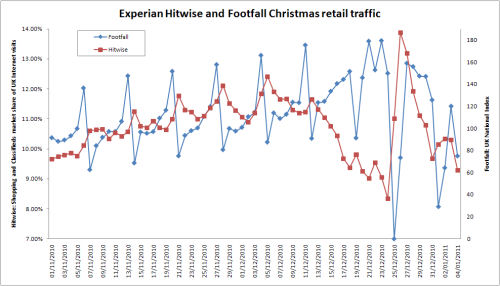Pavlov's consumer
Online traffic counter Experian Hitwise has published its figures for the UK holiday season and they reveal that the period immediately after Christmas - i.e. ‘the sales' - was the busiest ever for UK e-tail. This stands in stark contrast to bricks-and-mortar retail, which experienced a festive period below even pessimistic expectations.
While it's fairly logical that e-tail and retail would have some degree of inversely proportional relationship on the grounds that you're only going to make each purchase once, these figures also reveal that people tended to do their last-minute Christmas shopping offline and increasingly went online for the sales. We put this down to not wanting to wait for mail-order stuff to arrive.
"The two biggest factors which affected online retail this Christmas were the December snow falls and the January VAT increase," blogged Hitwise UK research director Robin Goad. "With consumers squeezed on both sides of Christmas, the period between 25 December 2010 and 4 January 2011 was the busiest post-Christmas shopping frenzy we've ever seen online."
This was illustrated in the first chart below, which shows an unprecedented e-tail spike of 23 percent immediately after Christmas. There was quite a big spike last year, as VAT also rose 2.5 percent then, but there was no VAT movement to start 2009, and hence hardly any spike.

We remain mystified by the apparent power of VAT changes to motivate consumers. If a local shop announced it was knocking 2.5 percent off its stock would that be sufficient to draw people in? We doubt it. We still think the VAT drop in late 2008 was a massive waste of money. It cost the state $12.5 billion, which it now desperately needs back, and surely did little to stimulate consumer spending bar the Pavlovian spasm caused when they were put back up.
Perhaps that's the answer: continually drop and raise VAT, on the grounds that each time they're about to put it back up everyone will rush out and buy stuff in order to ‘save' 2.5 percent.
Anyway, this second chart illustrates the inversely proportional relationship between retail and e-tail in the build-up to Christmas. Note, also, the fairly healthy numbers of online shoppers on Christmas day itself.














